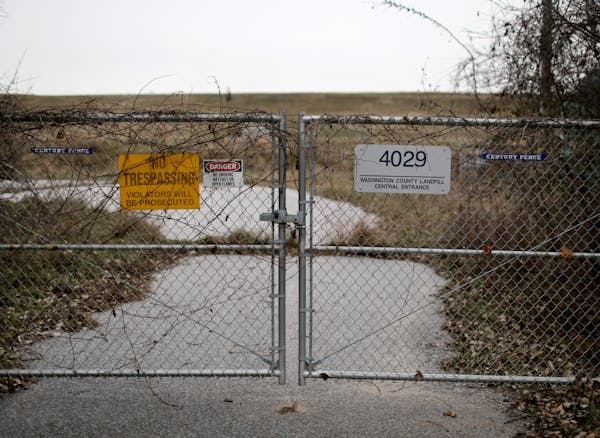As a real estate agent and homeowner in Stillwater, Carmel Rubel Carver became concerned in March when she learned that the city's water system had been tagged with a Minnesota Health Department advisory because of PFAS contamination.
She said she believes her lifelong struggles with autoimmune issues could be exacerbated by contaminated water. But when she tried to learn more about the test results, which wells were contaminated and whether the sites were feeding water to her home, Carver hit a wall.
"They're not sharing that data," she said, adding that she's called City Hall two or three times but didn't get satisfactory answers.
After years of watching Woodbury, Oakdale and Lake Elmo confront PFAS drinking water contamination, it's now Stillwater's turn. The city has been scrambling to keep up with the complex science of PFAS and human health, a litany of questions from residents and the question of who will pay for the costly cleanup estimated to be in the tens of millions of dollars.
It didn't help that Stillwater officials at first slow-walked the news that a city well was failing water tests, keeping the information in-house despite a Health Department notification last October that said it was time to tell the public. A Star Tribune story in March made it public; Stillwater has since created a web page with more information, including some of the latest test results for the worst wells.
The Health Department, in response to a public records request, provided more Stillwater test results going back several years. The results show that six of the city's eight wells have failed to meet the Health Department's most stringent health goals for a specific PFAS chemical – PFOA – and that two wells fail to meet the state's health goals for an additional chemical known as PFOS.
The goals, known as health-based values, set a very low level for specific contaminants as a means of measuring risk, said state toxicologist Kristine Klos. If city water is above that level, it doesn't mean that a person will automatically become sick, she said. "It's when we look at the population as a whole, most people will be OK, some people will be affected." The risks are greater for vulnerable populations, such as infants, and fetuses, she added.
The new goals fall as low as 0.0079 parts per trillion for PFOA. One part per trillion is roughly the equivalent of one drop of water in 20 Olympic-size swimming pools.
The city's two dirtiest wells — No. 6, located along Highway 95 south of downtown, and No. 10, near Lily Lake — also failed to meet a less-stringent national standard set in April by the Environmental Protection Agency. They have been shut down. Health department tests show both wells were above the EPA standard of 4 parts per trillion for PFOS as early as the fall of 2021. Well No. 9, near Lily Lake, had PFAS levels just below the EPA standard. Some of those test results are now shared on the city's website.
The federal standard is legally enforceable, unlike the state's health goals, and will require municipalities by 2029 to take action to reduce PFAS levels and notify the public.
The family of chemicals known as PFAS, short for per-and polyfluoroalkyl substances, was pioneered by 3M for use in manufacturing and today are in a wide variety of products, from food packaging to firefighting foam. The chemicals are resistant to water, oil, and heat and due to their tight carbon-flourine bonds are nearly indestructible, giving rise to their nickname as "forever chemicals."
A plume of PFAS chemicals has contaminated groundwater across the east metro because of four 3M dumpsites in Washington County, where the company disposed of PFAS manufacturing waste from the 1950s through the early 1970s. Some compounds, particularly the original ones known as PFOS and PFOA, have been linked to damage to the liver, the immune system and diseases including cancer.
Stillwater City Administrator Joe Kohlmann said the city estimates that it could cost up to $13 million per well to clean city water. The city is pursuing funds from the state bonding bill, the drinking water revolving loan fund, community project funding and a MPCA drinking water planning and design grant to help pay for water treatment, he said.
Some cities have paid for PFAS cleanup with money made available in 2018 when 3M settled a state lawsuit by creating a $850 million cleanup fund. The fund was created to clean up the PFAS plume from the Washington County disposal sites, but it's not yet known if Stillwater's contamination comes from any of those sites.
Even for cities allowed to use 3M settlement money, there's concern that funds will run out. Oakdale Mayor Kevin Zabel said his city needs to expand its water system and has accelerated plans fearing it will be more difficult to access cleanup funds in the future.
One of the latest cities to find PFAS in its water is Oak Park Heights, which borders Stillwater to the south. "It was probably just about a month ago that the testing came back, and the public works director let everybody know," said Mayor Mary McComber.
The city has created a website for residents, and signed on to the national $10.3 billion 3M settlement reached last summer for water cleanups across the country.
"There is money out there but when you think of how many cities are having big issues … I don't think that money is not going to be enough for everybody," said McComber.

'Safe recovery sites' would offer syringes, naloxone and more to people using drugs. The plan could be in peril.
New Minnesota GOP leaders seek peace with party's anti-establishment wing

Who is Republican Lisa Demuth, Minnesota's first House speaker of color?

